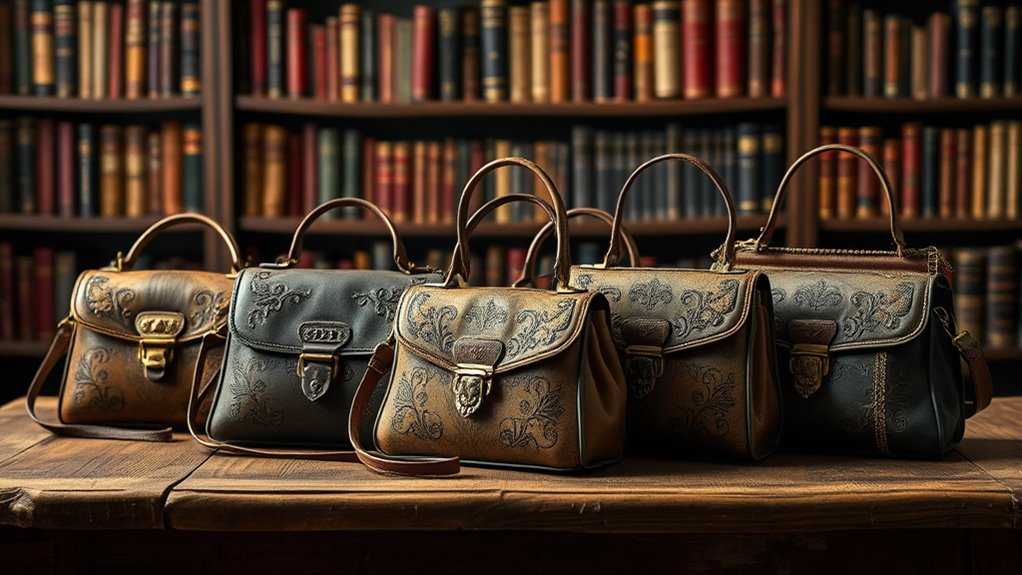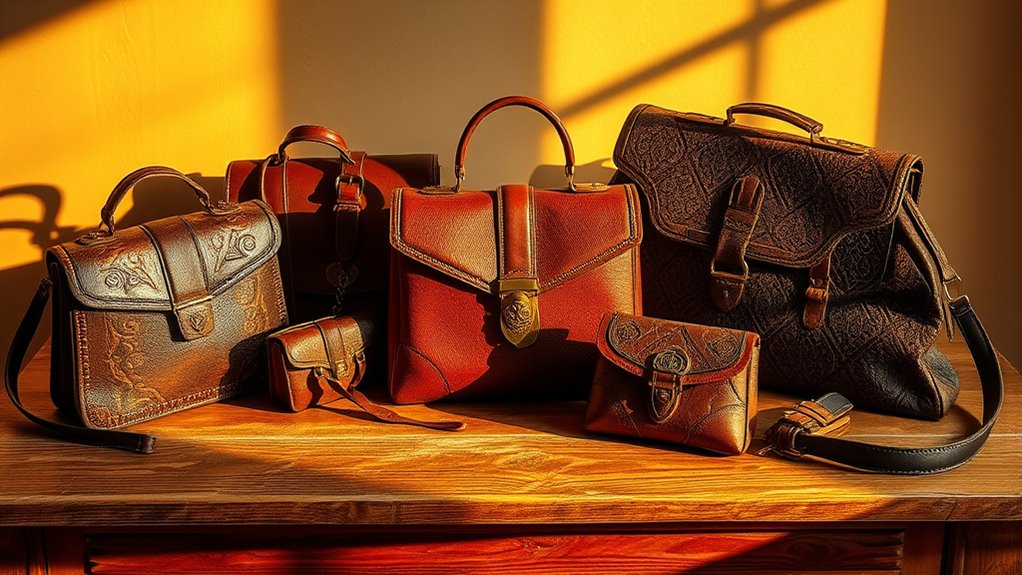Handbags in literature act as symbols that reveal your characters’ traits, emotions, and social standing. They show what’s inside their hearts—secrets, aspirations, or vulnerabilities—and can highlight their struggles or confidence. The way characters handle or display their handbags adds layers to their personality and relationships. By paying attention to these details, you uncover hidden motives and tensions that deepen the story. If you keep exploring, you’ll find even more ways these objects enrich storytelling.
Key Takeaways
- Handbags serve as symbolic objects revealing characters’ social status, emotional states, and personal secrets.
- They act as metaphors for inner baggage, aspirations, or vulnerabilities within narratives.
- Handbag interactions and conditions illustrate character development and internal conflicts.
- They create contrast and tension, highlighting societal roles or hidden motives.
- Descriptions of handbags enrich storytelling by adding layers of meaning and visual cues.

Throughout literature, handbags often symbolize more than just fashion accessories—they serve as powerful objects loaded with meaning. When writers include handbags in their stories, they’re not just describing an item; they’re tapping into a rich vein of symbolism that reveals character traits, emotional states, or societal roles. As you read, you might notice how a handbag becomes a reflection of a character’s inner world or a marker of their social standing. This is where fashion symbolism plays an important role, helping to deepen the narrative and add layers of meaning. Your understanding of a character’s personality can often hinge on the way they carry or treat their handbag—whether it’s pristine and expensive or worn and tattered. These details aren’t incidental; they’re deliberate choices by the author to weave character development into the fabric of the story.
Consider how a character’s handbag can embody their aspirations, secrets, or vulnerabilities. For example, a sleek, designer purse may symbolize wealth, sophistication, or a desire to impress others. Conversely, a battered bag might suggest hardship, resilience, or a refusal to conform. As you follow the character’s journey, the handbag becomes a visual cue that reveals their evolving identity. By observing these objects, you learn not only about the character’s external circumstances but also about their internal struggles. The handbag, in this way, acts almost like a metaphor for their personal narrative—carrying history, hope, or baggage—making it an essential tool for character development. Additionally, the integration of AI-driven analysis can help authors craft more nuanced descriptions of these objects, enhancing storytelling depth.
Authors often use handbags to create moments of contrast or tension. A character’s interaction with their bag can expose their true feelings or hidden motives. For instance, clutching a small bag tightly might indicate anxiety, while casually tossing a tote aside may reveal confidence or disregard. When you notice these subtleties, you gain insight into the emotional landscape of the story. Handbags, then, are more than just accessories; they’re storytelling devices that facilitate character exploration. They serve as visual shorthand, helping you interpret what’s beneath the surface, what lies beneath the fabric of appearances.
Frequently Asked Questions
How Do Handbags Reflect Character Development in Literature?
Handbags reflect your character development by embodying personal growth and emotional significance. As your story unfolds, the handbag may change—getting more worn or sophisticated—signaling shifts in values or maturity. You hold onto certain items for emotional reasons, revealing vulnerability or strength. Through these details, the handbag becomes a mirror of your internal journey, showing how you evolve and what you cherish most in moments of change.
What Are the Historical Origins of Handbags as Literary Symbols?
You might find it fascinating that handbags originated as practical items in ancient Egypt, symbolizing status and identity. Over time, their fashion evolution reflects societal shifts, with materials like leather and silk carrying deep symbolism of wealth and power. In literature, these symbols often reveal a character’s social standing or secrets, echoing their historical roots. Handbags have long served as powerful metaphors, blending fashion history with storytelling.
Are There Cultural Differences in Handbag Symbolism Across Literature?
You’ll notice cultural variations markedly influence handbag symbolism in literature. Regional symbolism shapes how characters view handbags, reflecting local values and gender roles. For example, in Western narratives, handbags often symbolize independence or status, while in some Asian stories, they may represent tradition or social harmony. These differences emphasize how regional symbolism impacts the way authors use handbags to deepen character development and cultural storytelling.
How Do Authors Use Handbags to Foreshadow Plot Twists?
You might think handbags just hold lipstick, but authors cleverly use them to foreshadow plot twists. When you open a handbag, you’re often met with unexpected discoveries or hidden messages that hint at surprises ahead. Writers embed clues inside these accessories, turning them into symbols of secrets waiting to be revealed. So, next time you see a handbag, remember—it could be the key to uncovering the story’s hidden twists.
Can Handbags Symbolize Social Status in Literary Works?
You can see handbags often symbolize social status in literature because they act as fashion statements, reflecting personal identity. When characters carry luxurious or distinctive handbags, it signals their wealth, taste, or social standing. This visual cue helps you understand their background or intentions without explicit dialogue, making the handbag a powerful symbol that reveals underlying social dynamics and character traits in the story.
Conclusion
As you’ve seen, handbags are more than just accessories; they hold stories, secrets, and symbolism that enrich literature. They serve as windows into characters’ lives, revealing their desires and struggles. Remember, the truth is often in the details, and a simple handbag can speak volumes. So, next time you see one in a story, know you’re holding a treasure trove of meaning—sometimes, it’s the little things that make all the difference.








